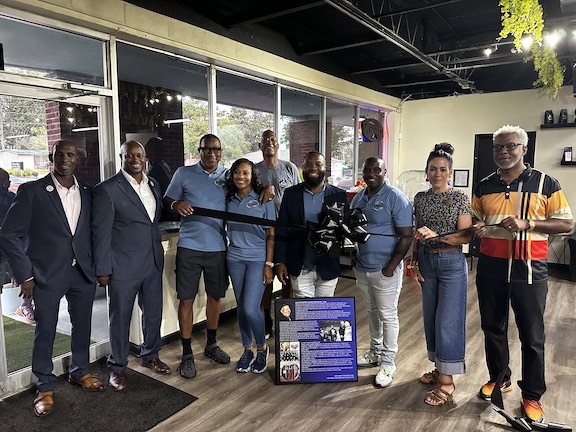Weight chaining
Published 11:46 pm Tuesday, June 13, 2006

- Valdosta State University sophomore football player Dedric Smith spots redshirt junior Davis Russell as he does variable resistance bench presses using chains as weights.
VALDOSTA — Walking into the weight room at Valdosta State, it’s a familiar sight as 200-pound plus football players grimace and struggle to lift what seems like the weight of an elephant off their chest.
Players are spread across the mirrored room on the bench press, lifting dumbbells, squatting and cling pressing while working on the speed and strength that has made the Blazers one of Division II’s best teams throughout the last seven years.
The reason they have been so formidable is because of their training, and that aspect of their conditioning has added an advantage this offseason.
While much of the weight room is standard issue, there are a few things that will be new to old-time weight trainers and not just the iPod and speaker setup blasting the latest in hip hop and rock n’ roll.
Along with racks of weights, dozens of large metal chains suitable for pulling a 4-by-4 out of the mud dangle along the walls.
“I thought it was pretty cool,” said junior quarterback Clay Callaway when first introduced to his new metallic workout partner. “You see those big chains in there and it looks pretty manly, pretty tough.”
The torture room decor does more than look manly, it makes the athletes of VSU tougher at a faster rate.
The football team started working out with chains less than two months ago and already the athletes are seeing a difference.
“I think it’s going to get us better,” Dedric Smith said. “I can tell the difference since we started using it.”
Smith, who now benches 305 pounds and squats 405, has added 20 pounds to his lift since before last season’s max workout was recorded.
What is this new technique and why does it work?
Using chains in a strength conditioning program is simply adding chains to each side of the bar.
Dragging chains, along with the weight already on a bar into the air, adds strength by building speed through variable resistance.
“It should get them used to heavier weights because they can get more than their max at the top, and as it goes lower you get less than their max,” VSU’s strength and conditioning coach Michael Doscher said. “As it goes back up, it gets stronger.
“It follows the muscle curve.”
When Callaway was asked to explain the advantages of lifting with chains, he simplified it.
“It’s different, but it works,” he said. “Somehow or another it gets you stronger. I can’t get really get into the scientific terms.”
The chains add 20-30 pounds of weight at the top of a bench press and recoil on the floor when the bar gets lowered to provide the original weight.
“The chains help increase max plus add explosiveness,” junior center Davis Russel said.
Having chains on the bar during bench press also helps athletes lift through their sticking point and lift a higher amount of weight.
“He could do a lot more weight probably coming up, but it gets past the sticking point,” Doscher said. “This way it takes weight off the shoulder and past the sticking point and gets more weight.”
With an ease in lifting transition the chains also take pressure off the joints, takes the weight off the shoulders and helps work the core.
The use of chains in a conditioning program comes from Louie Simmons and Westside Barbell Club. Doscher brought the chains to VSU in January after researching for two years.
When the football team first saw chains brought into the weight room the reaction was that of strange curiosity.
“I was like, oh my goodness,” Smith said. “What is this going to help?”
However, after a month of using the technique, the comments have changed.
“We were skeptical, but everybody’s gotten used to it,” linebacker William Montford said. “They like it now.”
The football players aren’t the only athletes using chains at VSU. The men’s and women’s basketball teams started with chains in January and the volleyball team and rest of Blazers’ athletics will begin this summer.
The volleyball team can use chains on shoulder presses, squats and lunges to build up arm and leg strength.
For the football team, the workouts will translate on the field into more balance and expressiveness in tackles and blocks.
“Everything on the football field is explosive,” Russel said. “Those chains and bands add explosiveness to your workout.”
Last offseason, VSU added bands to its lifting regimen, strapping large rubber bands to the end of the bars.
The bands also help explosiveness but add “punch” to the end of a lift.
The Blazers also use another odd tool in working out as they power press and squat with a large log filled with 25 pounds of water. The log forces the athletes to maintain balance while lifting weights, adding even more strength.
While VSU is just catching on with adding chains to its workouts, other schools have been using it for years.
The University of Georgia has used chains for six years, and Callaway used the method at Oconee County High School.
“It’s working (at UGA),” said Callaway son of offensive coordinator Neil Callaway said. “Obviously, it does wonders up there for sure.”
The University of Florida, Texas and the Air Force Academy football programs also use chains in working out.
“A lot of schools are doing it now,” Russel said. “It’s helping us like it’s helped them.”





